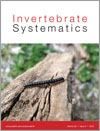IS15031Morphological cladistic analysis resolves the generic limits of the Neotropical potter wasp genera Minixi Giordani Soika and Pachyminixi Giordani Soika (Hymenoptera : Vespidae : Eumeninae)
The phylogenetic relationships among species of the potter wasp genera Minixi and Pachyminixi were investigated. As a result, Pachyminixi was synonymised under Minixi, corroborating hypotheses previously addressed elsewhere. This contribution is an addition to the continued systematic revision of the Neotropical Eumeninae, whose generic classification progresses onto a natural one.




